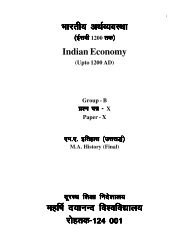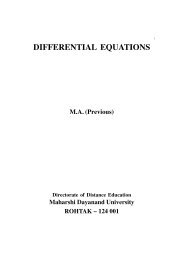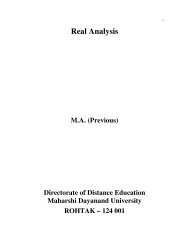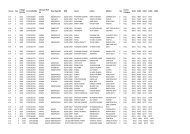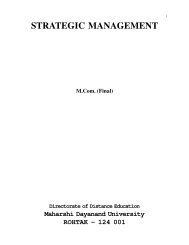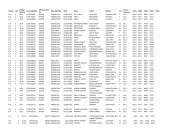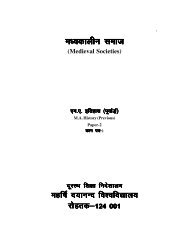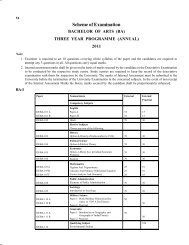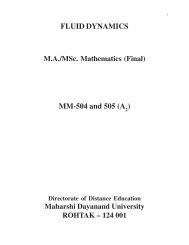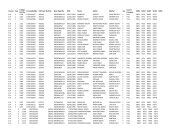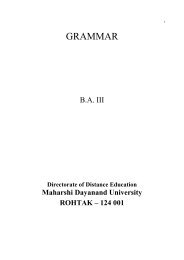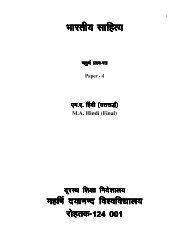Advanced Abstract Algebra - Maharshi Dayanand University, Rohtak
Advanced Abstract Algebra - Maharshi Dayanand University, Rohtak
Advanced Abstract Algebra - Maharshi Dayanand University, Rohtak
Create successful ePaper yourself
Turn your PDF publications into a flip-book with our unique Google optimized e-Paper software.
UNIT-IV 101<br />
Then either<br />
(i)<br />
or<br />
n<br />
i<br />
g(x) = b i<br />
x , b n ≠ 0 .<br />
i=<br />
0<br />
deg f(x) < deg g(x)<br />
(ii) deg f(x) ≥ deg g(x)<br />
In the first case we write<br />
f(x) = g(x) 0 + f(x)<br />
so that q(x) = 0 and r(x) = f(x).<br />
In respect of the second case we shall prove the existence of q(x) and r(x) by mathematical induction on<br />
the degree of f(x). If deg f(x) = 1, then the existence of q(x) and r(x) is obvious. Let us suppose that the<br />
result is true when deg f(x) ≤ m−1. If<br />
a<br />
m<br />
h(x) = f(x) − <br />
x m−n g(x)<br />
bn<br />
<br />
f(x) = a 0 + a 1 x + … + a m x m<br />
= a m b n −1 x m−n (b 0 + b 1 x + … b n x n )<br />
(iii)<br />
+ (a m−1 − a m b n −1 b n−1 ) x m−1 + (a m−2 − a m b n −1 b n−2 ) x m−2<br />
= a m b n −1 x m−n g(x) + h(x)<br />
then deg h(x) ≤ m−1.<br />
Hence by supposition<br />
h(x) = g(x) q 1 (x) +r(x) ,<br />
where r(x) = 0 or deg r(x) < deg g(x) .<br />
From (iii) and (iv) we have<br />
a<br />
f(x) −<br />
<br />
b<br />
That is,<br />
m<br />
n<br />
<br />
<br />
x m−n g(x) = g(x) q 1 (x) + r(x)<br />
a<br />
f(x) = g(x) [q 1 (x) +<br />
<br />
b<br />
= g(x) q(x) + r(x)<br />
m<br />
n<br />
<br />
x m−n ] + r(x)<br />
<br />
a<br />
m<br />
where q(x) = q 1 (x) + <br />
x m−n<br />
bn<br />
<br />
Thus existence of q(x) and r(x) is proved.<br />
Now we shall prove the uniqueness of q(x) and r(x).<br />
Let us suppose that q 1 (x) and r 1 (x) are two polynomials belonging to F[x] such that<br />
f(x) = g(x) q 1 (x) + r 1 (x)<br />
where r 1 (x) = 0 or deg r 1 (x) < deg g(x).<br />
But by the statement of the theorem, q(x) and r(x) are two elements of F(x) such that<br />
f(x) = g(x) q(x) + r(x)<br />
where r(x) = 0 or deg r(x) < deg g(x).<br />
Hence<br />
(iv)



